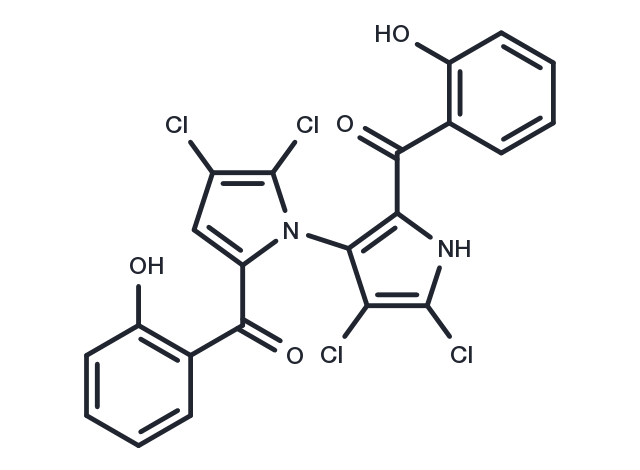Powder: -20°C for 3 years | In solvent: -80°C for 1 year


Maritoclax (Marinopyrrole A) (Marinopyrrole A) is a novel and specific Mcl-1 inhibitor, shows <8 fold selectivity than BCL-xl (IC50 < 80 μM),with an IC50 value of 10.1 μM.

| Pack Size | Availability | Price/USD | Quantity |
|---|---|---|---|
| 1 mg | In stock | $ 38.00 | |
| 2 mg | In stock | $ 54.00 | |
| 5 mg | In stock | $ 89.00 | |
| 10 mg | In stock | $ 147.00 | |
| 25 mg | In stock | $ 293.00 | |
| 50 mg | In stock | $ 547.00 | |
| 100 mg | In stock | $ 763.00 | |
| 1 mL * 10 mM (in DMSO) | In stock | $ 97.00 |



| Description | Maritoclax (Marinopyrrole A) (Marinopyrrole A) is a novel and specific Mcl-1 inhibitor, shows >8 fold selectivity than BCL-xl (IC50 > 80 μM),with an IC50 value of 10.1 μM. |
| Targets&IC50 | MCL1:10.1 μM |
| In vitro | Maritoclax (Marinopyrrole A) (3 μM) induced-cell death is associated with MCL1 decrease and translation inhibition. Maritoclax (Marinopyrrole A) induces a dephosphorylation of EIF4EBP1 concomitant to a decrease of EIF4E phosphorylation[3]. Maritoclax (Marinopyrrole A) is much more effective against Bcl-2-dependent RS4;11 cells (IC50: 2 μM) when compared to Mcl-1-dependent HeLa cells (IC50: 20 μM)[4].Maritoclax (Marinopyrrole A) blocks the binding of Bim BH3 α-helix to Mcl-1 but not Bcl-XL. Maritoclax (Marinopyrrole A) markedly inhibits the viability of Mcl-1-IRES-BimEL cells (EC50=1.6 μM) with a selectivity greater than 40-fold over Bcl-2-IRES-BimEL (EC50=65.1 μM) and Bcl-XL-IRES-BimEL (EC50=70.0 μM) cells. Maritoclax (Marinopyrrole A) induces cell death selectively in Mcl-1-dependent but not Bcl-2- or Bcl-XL-dependent leukemia cells. Maritoclax (Marinopyrrole A) induces proteasome-mediated Mcl-1 degradation without induction of Mcl-1 phosphorylation and Noxa expression. Maritoclax (Marinopyrrole A) inhibits Mcl-1 interaction with Bim in intact cells and triggers cytochrome c release from isolated mitochondria. Maritoclax (Marinopyrrole A) synergistically sensitizes lymphoma/leukemia cells to ABT-737[1]. Maritoclax (Marinopyrrole A) shows activity against all tested S. aureus strains, including glycopeptide-intermediate and vancomycin-resistant MRSA, and has potent activities against other Gram-positive organisms. In addition, Maritoclax (Marinopyrrole A) is active against H. influenzae but is inactive against other tested Gram-negative strains. Maritoclax (Marinopyrrole A) displays substantial concentration-dependent killing against MRSA strain TCH1516 and is far more rapid in its antibiotic action than either vancomycin or linezolid. Maritoclax exhibits a favorable therapeutic index, with 50% inhibitory concentrations (IC50) in excess of 20× above the MIC in each case: 32 to 64 μg/mL against HeLa cells and 8 to 32 μg/mL against L929 cells[2]. |
| Synonyms | Marinopyrrole A |
| Molecular Weight | 510.15 |
| Formula | C22H12Cl4N2O4 |
| CAS No. | 1227962-62-0 |
Powder: -20°C for 3 years | In solvent: -80°C for 1 year
DMSO: 43 mg/mL (84.29 mM)
You can also refer to dose conversion for different animals. More
bottom
Please see Inhibitor Handling Instructions for more frequently ask questions. Topics include: how to prepare stock solutions, how to store products, and cautions on cell-based assays & animal experiments, etc.
Maritoclax 1227962-62-0 Apoptosis BCL Inhibitor Bcl-2 Family inhibit Marinopyrrole A inhibitor
